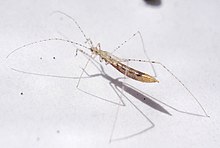Empicoris vagabundus
| Empicoris vagabundus | ||||||||||||
|---|---|---|---|---|---|---|---|---|---|---|---|---|

Empicoris vagabundus |
||||||||||||
| Systematics | ||||||||||||
|
||||||||||||
| Scientific name | ||||||||||||
| Empicoris vagabundus | ||||||||||||
| ( Linnaeus , 1758) |
Empicoris vagabundus is a species of bug from the family of predatory bugs (Reduviidae).
features
The bugs are 5.8 to 7.2 millimeters long. With their mosquito-like body, they resemble stilt bugs (Berytidae), but can easily be distinguished from them by their curved rostrum. Empicoris vagabundus can be distinguished from the similar species of the genus Empicoris that occur in the same area on the basis of their size and the pale sides of the connexivium. The scutellum has a thorn. The antennae and the legs ( femora ) are darkly ringed. The foremost pair of legs is modified into robotic legs. Point eyes ( Ocelli ) are missing.
Occurrence and habitat
The species is widespread in Europe, east across Siberia and Central Asia to northern China. It is absent in the southern Mediterranean countries. It was introduced into North America by humans. It occurs everywhere in Germany and Austria and has also been proven in the higher elevations of the low mountain ranges and the Alps up to over 1000 meters above sea level. It is not uncommon. It is preferred to colonize shady habitats with higher humidity. Sunny places are avoided.
Way of life
Empicoris vagabundus lives on deciduous and coniferous trees such as oaks ( Quercus ), elms ( Ulmus ), linden ( Tilia ), apples ( Malus ), spruce ( Picea ), larch ( Larix ), juniper ( Juniperus ) and arborvitae ( Thuja ). They are mainly found on the trunk and branches of old trees with lichen and moss growth. They often live on the dead lower branches of spruce trees. There they hunt their presumably main prey, dust lice (Psocoptera). In Central Europe, it is likely that the adults overwinter . The mating is documented both in autumn and in spring. The females lay their eggs in May. The nymphs appear in early and midsummer, the adults of the new generation from July, but mostly from August. There seem to be regional differences in the development cycle in different years. Since nymphs can also be found in winter, it would be conceivable that a two-year development with two hibernation periods, once as a nymph and once as an adult bug, is possible.
supporting documents
Individual evidence
- ^ A b c Ekkehard Wachmann , Albert Melber, Jürgen Deckert: Bugs. Volume 1: Cimicomorpha: Dipsocoromorpha, Nepomorpha, Gerromorpha, Leptopodomorpha, Cimicomorpha (part 1) (= The animal world of Germany and the adjacent sea parts according to their characteristics and according to their way of life . 77th part). Goecke & Evers, Keltern 2006, ISBN 3-931374-49-1 , p. 219 .
- ↑ Empicoris vagabundus. British Bugs, accessed July 5, 2015 .
- ↑ Frieder Sauer: Sauer's nature guide recognized bugs and cicadas from color photos . Fauna, Keltern 1996, ISBN 3-923010-12-5 , p. 122 .
literature
- Frieder Sauer: Sauer's nature guide recognized bugs and cicadas from color photos . Fauna, Keltern 1996, ISBN 3-923010-12-5 .
- Ekkehard Wachmann , Albert Melber, Jürgen Deckert: Bugs. Volume 1: Cimicomorpha: Dipsocoromorpha, Nepomorpha, Gerromorpha, Leptopodomorpha, Cimicomorpha (part 1) (= The animal world of Germany and the adjacent sea parts according to their characteristics and according to their way of life . 77th part). Goecke & Evers, Keltern 2006, ISBN 3-931374-49-1 .
Web links
- Empicoris vagabundus in Fauna Europaea. Retrieved July 5, 2015
